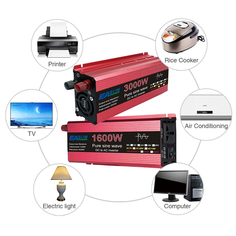Embarking on a camping adventure often means leaving behind the comforts of home, but it doesn't have to mean sacrificing all modern conveniences. A compact pure sine wave inverter can be a game-changer, providing reliable power for your electronic devices. This guide will walk you through the essentials of selecting the perfect inverter for your outdoor escapades.

Understanding Pure Sine Wave Inverters
Before diving into the specifics of choosing a compact pure sine wave inverter for camping, it's crucial to understand what a pure sine wave inverter is. Unlike modified sine wave inverters, pure sine wave inverters produce a smooth, consistent wave of electricity that mimics the power from your home outlets. This ensures that sensitive electronics, such as laptops and medical devices, operate efficiently and safely.
Why Choose a Compact Inverter?
When camping, space and weight are at a premium. A compact pure sine wave inverter is designed to be lightweight and portable, making it an ideal choice for outdoor enthusiasts. These inverters are easy to pack and carry, ensuring that you have access to reliable power without being weighed down by bulky equipment.
Key Features to Consider
Choosing the right compact pure sine wave inverter for camping involves evaluating several key features:
- Power Output: Determine the wattage you need by listing all the devices you plan to power. Ensure the inverter can handle the combined wattage of these devices.
- Portability: Look for inverters that are lightweight and have a compact design. Consider models with built-in handles or carrying cases for added convenience.
- Battery Compatibility: Ensure the inverter is compatible with the type of battery you plan to use, whether it's a car battery, deep cycle battery, or a portable power station.
- Safety Features: Opt for inverters with built-in protections against overloading, short-circuiting, and overheating to safeguard both the inverter and your devices.
- Efficiency: High-efficiency inverters convert more of the battery's power into usable electricity, extending the life of your battery and providing more power for your devices.
Practical Applications and Examples
Imagine you're on a week-long camping trip in a remote location. You need to charge your smartphone, power a small fan, and occasionally use a laptop. A compact pure sine wave inverter with a 300-watt output would be sufficient for these needs. Its portability ensures it fits easily in your camping gear, and its efficiency maximizes your battery life.
For more demanding applications, such as running a mini-fridge or a CPAP machine, a higher wattage inverter, around 1000 watts, would be necessary. Despite the increased power, many models remain compact and easy to transport.
Conclusion
The ultimate guide to choosing a compact pure sine wave inverter for camping emphasizes the importance of understanding your power needs and selecting an inverter that balances power output, portability, and safety. By considering these factors, you can ensure a reliable power source for your camping adventures, allowing you to enjoy the great outdoors without compromising on modern conveniences.
Whether you're a seasoned camper or a weekend warrior, a compact pure sine wave inverter is an invaluable addition to your gear. It provides peace of mind, knowing that you can power essential devices and stay connected, no matter where your adventures take you.







